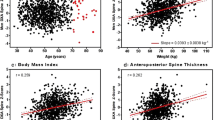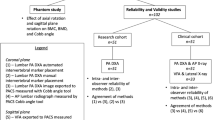Abstract
We report a study to assess whether supine lateral dual-energy X-ray absorptiometry (DXA) scans of the lumbar spine provide better data for monitoring response to treatment than alternative measurement sites such as the posteroanterior (PA) spine, hip and total body. The study population was 152 women enrolled in a placebo-controlled clinical trial of cyclical etidronate therapy. All subjects were 1–10 years after the menopause with bone mineral density (BMD) between 0 and −2 SD of age-matched normal women. Paired PA and lateral spine, left hip and total-body DXA scans were performed at baseline, 1 year and 2 years on a Hologic QDR-2000. One hundred and thirty-one subjects completed the study. Mean percentage change from baseline at 2 years in the treated (n=61) and control (n=70) groups was calculated for vertebral body, width-adjusted (WA) vertebral body, mid-vertebral body and WA mid-vertebral body BMD measurements on the lateral scans and compared with the percentage changes in PA spine, femoral neck, trochanter, Ward's triangle and total-body BMD. The long-term precision for each BMD measurement site was obtained by linear regression analysis in subjects taking placebo. Overall treatment effect, defined as the difference in the percentage change in BMD in the two treatment groups at 2 years, was divided by long-term precision to give an index of the ability of each site to monitor response to treatment. Results (and standard errors) normalized to the ratio of treatment effect/precision for PA spine BMD were as follows: PA spine, 1.00; vertebral body, 0.89 (0.14); WA vertebral body, 0.78 (0.14); mid-vertebral body, 0.65 (0.14); WA mid-vertebral body, 0.60 (0.13); femoral neck, 0.35 (0.15); trochanter, 0.45 (0.15); Ward's triangle, 0.59 (0.22); total body, 0.52 (0.19). Although treatment effect was larger for lateral than for PA spine BMD, this advantage was offset by the greater precision errors. PA spine BMD remains the optimum measurement for longitudinal studies in recently postmenopausal women.
Similar content being viewed by others
References
Cullum ID, Ell PJ, Ryder JP. X-ray dual photon absorptiometry: a new method for the measurement of bone density. Br J Radiol 1989;62:587–92.
Wahner HW, Fogelman I. The evaluation of osteoporosis: dual energy x-ray absorptiometry in clinical practice. London: Martin Dunitz, 1994.
Whitehouse RW, Karantanas A, Adams JE. Discrepancies in spinal bone mass measured by QCT and DXA. In: Ring EFJ, editor. Current research in osteoporosis and bone mineral measurement II. London: British Institute of Radiology, 1992:26.
Guglielmi G, Grimston SK, Fischer KC, Pacifici R. Osteoporosis: diagnosis with lateral and posteroanterior dual x-ray absorptiometry compared with quantitative CT. Radiology 1994;192:845–50.
Mazess RB, Barden HS, Eberle RW, Denton MD. Age changes of spine density in posterior-anterior and lateral projections in normal women. Calcif Tissue Int 1995;56:201–5.
Finkelstein JS, Cleary RL, Butler JP, Antonelli R, Mitlak BH, Deraska DJ, et al. A comparison of lateral versus anterior-posterior spine dual energy x-ray absorptiometry for the diagnosis of osteopenia. J Clin Endocrinol Metab 1995;78:724–30.
Jergas M, Breitenseher M, Glüer C-C, Yu W, Genant HK. Estimates of volumetric bone density from projectional measurements improve the discriminatory capability of dual x-ray absorptiometry. J Bone Miner Res 1995;10:1101–10.
Peel NF, Eastell R. Diagnostic value of estimated volumetric bone mineral density of the lumbar spine in osteoporosis. J Bone Miner Res 1994;9:317–20.
Bjarnason K, Nilas L, Hassager C, Christiansen C. Dual energy x-ray absorptiometry of the spine — decubitus lateral versus anteroposterior projection in osteoporotic women: comparison to single energy x-ray absorptiometry of the forearm. Bone 1995;16:255–60.
Del Rio L, Pons F, Huguet M, Setoain FJ, Setoain J. Anteroposterior versus lateral bone mineral density of spine assessed by dual x-ray absorptiometry. Eur J Nucl Med 1995;22:407–12.
Slosman DO, Rizzolli R, Donath A, Bonjour J-P. Vertebral bone mineral density measured laterally by dual-energy X-ray absorptiometry. Osteoporosis Int 1990;1:23–9.
Larnach TA, Boyd SJ, Smart RC, Butler SP, Rohl PG, Diamond TH. Reproducibility of lateral spine scans using dual energy X-ray absorptiometry. Calcif Tissue Int 1992;51:255–8.
Lilley J, Eyre S, Walters B, Heath DA, Mountford PJ. An investigation of spinal bone mineral density measured laterally: a normal range for UK women. Br J Radiol 1994;67:157–61.
Blake GM, Jagathesan T, Herd RJM, Fogelman I. Dual X-ray absorptiometry of the lumbar spine: the precision of paired anteroposterior/lateral studies. Br J Radiol 1994;67:624–30.
Formica C, Loro M-L, Gilsanz V, Seeman E. Inhomogeneity in body fat distribution may result in inaccuracy in the measurement of vertebral bone mass. J Bone Miner Res 1995;10:1504–11.
Steiger P, Von Stetten E, Weiss H, Stein JA. Paired AP and lateral supine dual X-ray absorptiometry of the spine: initial results with a 32 detector system [abstract]. Osteoporosis Int 1991;1:190.
Sabin M, Blake GM, MacLaughlin-Black SM, Fogelman I. The accuracy of volumetric bone density measurements in dual X-ray absorptiometry. Calcif Tissue Int 1995;56:210–4.
Ryan PJ, Blake GM, Fogelman I. Screening for postmenopausal osteopenia. Br J Rheumatol 1992;31:823–8.
Bland M. An introduction to medical statistics, 2nd edn. Oxford: Oxford University Press, 1995.
Glüer C-C, Blake G, Lu Y, Bunt BA, Jergas M, Genant HK. Accurate assessment of precision errors: how to measure the reproducibility of bone densitometry techniques. Osteoporosis Int 1995;5:262–70.
Schlesselman JJ. Planning a longitudinal study. I. Sample size determination. J Chronic Dis 1973;26:553–60.
Schlesselman JJ. Planning a longitudinal study. II. Frequency of measurement and study duration. J Chronic Dis 1973;26:561–70.
Glüer C-C, Faulkner KG, Estilo MJ, Engelke K, Rosin J, Genant HK. Quality assurance for bone densitometry research studies: concept and impact. Osteoporosis Int 1993;3:227–35.
Herd RJM, Blake GM, Ryan PJ, Fogelman I. A 152 patient double blind placebo controlled study of cyclical etidronate therapy for the prevention of early postmenopausal bone loss. J Bone Miner Res 1995;10(Suppl 1):S153.
Author information
Authors and Affiliations
Rights and permissions
About this article
Cite this article
Blake, G.M., Herd, R.J.M. & Fogelman, I. A longitudinal study of supine lateral DXA of the lumbar spine: A comparison with posteroanterior spine, hip and total-body DXA. Osteoporosis Int 6, 462–470 (1996). https://doi.org/10.1007/BF01629579
Received:
Accepted:
Issue Date:
DOI: https://doi.org/10.1007/BF01629579




